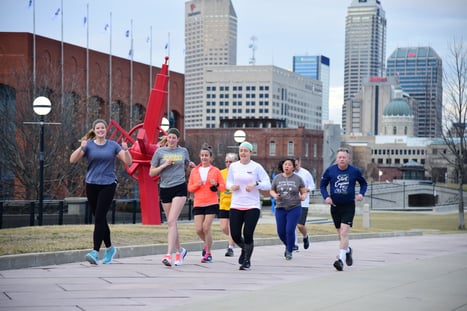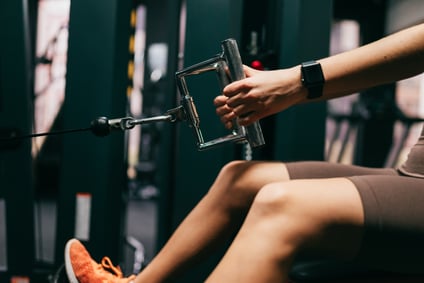The New England Journal of Medicine published a study of adults showing that the average holiday weight gain was .37 kilograms, or just under a pound, and more than half the people in the study stayed within a kilogram, or just over two pounds, of their other weigh-ins. Now that the holidays are over, you can lose that weight and stay healthy during the long colder months. Here are five healthy habits to get started with.
 1. Do make a plan to manage your stress level.
1. Do make a plan to manage your stress level.
A good place to start is finding ways to ease stress and anxiety when they occur, or even before. That may mean doing yoga or meditation, taking a hot bath or shower, listening to music, or even just calling a friend to catch up. Just 10 minutes of stress relief can help you feel more relaxed and make it less likely that you will turn to food. If you’re having trouble finding time to unwind, mark a daily 10-minute stress break on your calendar and tag it with an alert—then treat it like you would an important appointment and don’t miss it.
2. Don’t skip meals to “save up” for a big dinner.
Some people skip meals to “save up” calories for a big dinner or party, but this approach may backfire and lead to overeating later. Instead, limit your intake to an eight-hour window of time each day. This has been shown to be an effective weight-maintenance strategy. You can even try having a lighter breakfast and lunch at your usual times, making sure they incorporate a lot of vegetables and proteins with minimal carbs. For example, you might have a cup of Greek yogurt for breakfast, a green salad with grilled chicken and light dressing for lunch, and then let yourself enjoy the evening feast.
3. Do eat your foods in a specific order.
It helps to have a plate of salad or vegetables before anything else. These low-calorie and high-fiber foods will help you fill up before you dive into the higher-calorie options. Next, have some type of lean protein. If you are going to have carbs (such as potatoes, chips, rice, pasta, bread, or a sweet dessert), save them for the end of your meal. By then, you’ll be less hungry and the protein you’ve eaten will slow your digestion a bit, so you’ll feel full for longer afterward.
4. Don’t forget that beverages count.
An easy way to cut calories is to avoid drinks like regular soda, juice, coffee drinks with added sugar, and alcoholic beverages. Also, try to aim for six to eight glasses of water per day. If you do decide to drink alcohol, choose spirits mixed with something without added sugar, such as seltzer or diet tonic water, rather than beer, wine, or mixed drinks. Or stick to a drink that has only about 100 calories per serving. Do keep in mind that alcohol can lower inhibitions and make you more likely to indulge, so limit yourself to one or two drinks, and have a glass of water after each one.
5. Do give in to your cravings (somewhat).
Controlling diet and weight is a balancing act. Completely cutting out dessert and sweets is simply unrealistic. This can lead to binging or eating more than you’d like to. If you are really craving your favorite sweet, let yourself have some. Remind yourself that this won’t be your last dessert ever and try to put the fork down after one slice—or a few bites, if you’re satisfied by that.
Check back soon for the next 5 ideas (part 2) for how to stay healthy during these colder months.
This blog was written by David Behrmann, NIFS Health Fitness Instructor. To learn more about the NIFS bloggers, click here.


 Running with others is one of the most effective strategies for creating a running habit and continuing it. The social benefits of running are among the biggest reasons why runners start and stick with running. Whether you’re running with one friend or a running group, here are some ways you can benefit from group running.
Running with others is one of the most effective strategies for creating a running habit and continuing it. The social benefits of running are among the biggest reasons why runners start and stick with running. Whether you’re running with one friend or a running group, here are some ways you can benefit from group running. Let’s be real. We aren’t always motivated to work out, and sometimes it’s hard to find that motivation. It’s even harder to find motivation when you don’t even enjoy exercise. It’s important to learn why getting active is so important, and it all starts with changing your mindset about it.
Let’s be real. We aren’t always motivated to work out, and sometimes it’s hard to find that motivation. It’s even harder to find motivation when you don’t even enjoy exercise. It’s important to learn why getting active is so important, and it all starts with changing your mindset about it.  In this blog series, I have discussed
In this blog series, I have discussed  You’ve probably heard the saying that “not all carbohydrates are bad,” but how do you differentiate between good and not-so-good for you? When it comes to carbohydrates, in order to identify which type is best, it’s important to first understand the
You’ve probably heard the saying that “not all carbohydrates are bad,” but how do you differentiate between good and not-so-good for you? When it comes to carbohydrates, in order to identify which type is best, it’s important to first understand the  The holiday season is here. That means a lot of us will be traveling to see family and friends. You might be worried about not being able to keep up with your fitness routine while on the road. I am here to show you workouts that do not require a gym.
The holiday season is here. That means a lot of us will be traveling to see family and friends. You might be worried about not being able to keep up with your fitness routine while on the road. I am here to show you workouts that do not require a gym.  Did you know
Did you know  As the weather turns colder and we spend more time indoors, viruses will become more active among the population. Healthy eating can help you boost your immunity. Here are five of the top choices for fighting colds and flu with food.
As the weather turns colder and we spend more time indoors, viruses will become more active among the population. Healthy eating can help you boost your immunity. Here are five of the top choices for fighting colds and flu with food. With the holidays coming up, it can be easy to get caught up in the busyness of it all. From Thanksgiving to Christmas, we are bombarded with festive meals, holiday parties, sweet treats, and family gatherings that simply interrupt our normal routine. The holiday season is one of the most difficult times to stay motivated to be healthy. Not to mention the fact that it is several degrees cooler and I would rather hibernate than go out to the gym. Plus, many of us travel to visit family and friends and we are just not close to our gym.
With the holidays coming up, it can be easy to get caught up in the busyness of it all. From Thanksgiving to Christmas, we are bombarded with festive meals, holiday parties, sweet treats, and family gatherings that simply interrupt our normal routine. The holiday season is one of the most difficult times to stay motivated to be healthy. Not to mention the fact that it is several degrees cooler and I would rather hibernate than go out to the gym. Plus, many of us travel to visit family and friends and we are just not close to our gym.  With inflation at a 40-year high and grocery costs up close to
With inflation at a 40-year high and grocery costs up close to